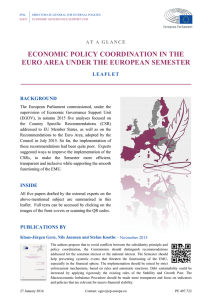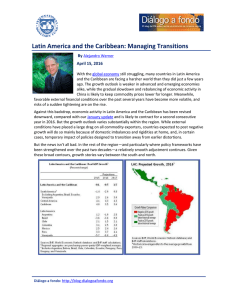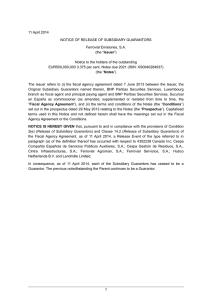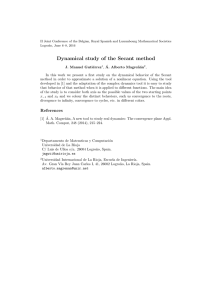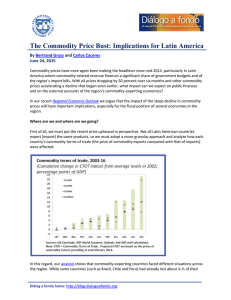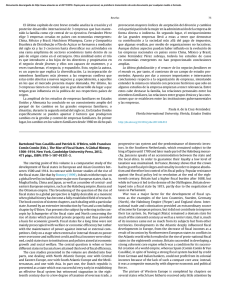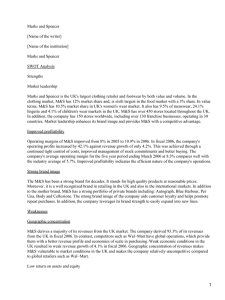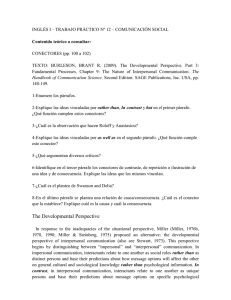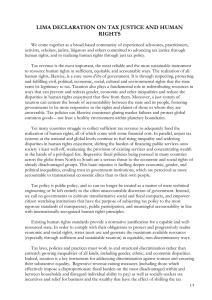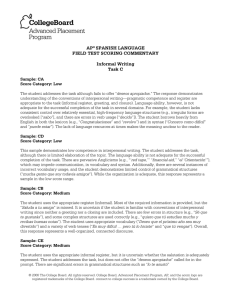interior hp 196 - Instituto de Estudios Fiscales
Anuncio
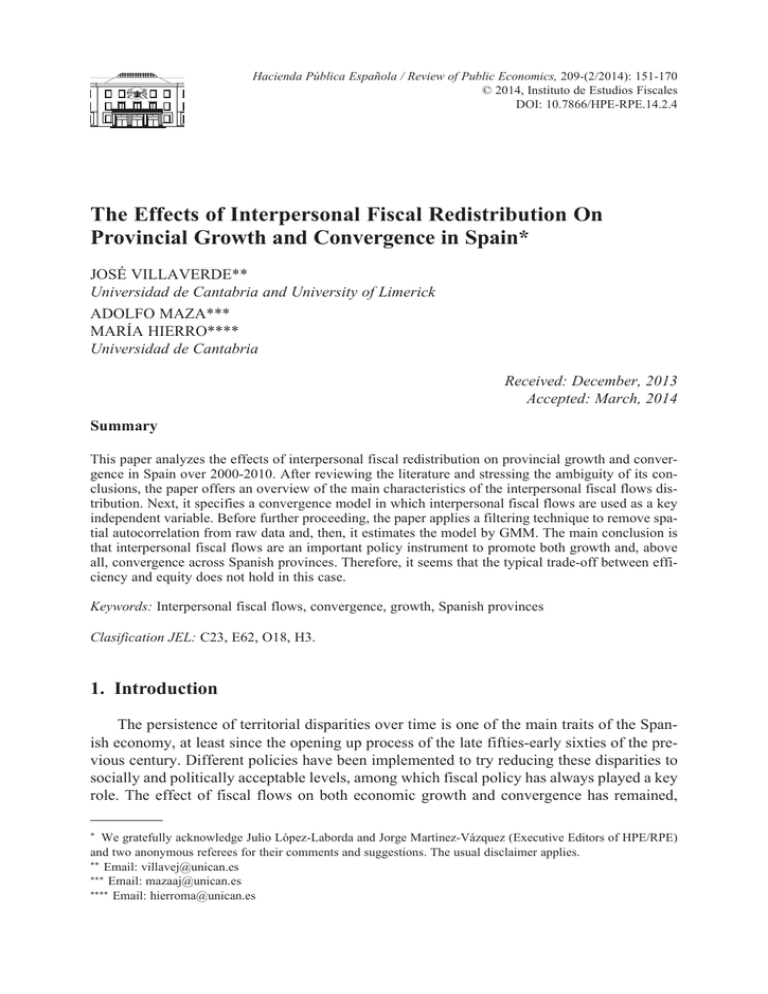
Hacienda Pública Española / Review of Public Economics, 209-(2/2014): 151-170 © 2014, Instituto de Estudios Fiscales DOI: 10.7866/HPE-RPE.14.2.4 The Effects of Interpersonal Fiscal Redistribution On Provincial Growth and Convergence in Spain* JOsé VILLaVERDE** Universidad de Cantabria and University of Limerick aDOLFO MaZa*** MaRÍa HIERRO**** Universidad de Cantabria Received: December, 2013 Accepted: March, 2014 Summary This paper analyzes the effects of interpersonal fiscal redistribution on provincial growth and convergence in spain over 2000-2010. after reviewing the literature and stressing the ambiguity of its conclusions, the paper offers an overview of the main characteristics of the interpersonal fiscal flows distribution. Next, it specifies a convergence model in which interpersonal fiscal flows are used as a key independent variable. Before further proceeding, the paper applies a filtering technique to remove spatial autocorrelation from raw data and, then, it estimates the model by GMM. The main conclusion is that interpersonal fiscal flows are an important policy instrument to promote both growth and, above all, convergence across spanish provinces. Therefore, it seems that the typical trade-off between efficiency and equity does not hold in this case. Keywords: Interpersonal fiscal flows, convergence, growth, spanish provinces Clasification JEL: C23, E62, O18, H3. 1. Introduction The persistence of territorial disparities over time is one of the main traits of the spanish economy, at least since the opening up process of the late fifties-early sixties of the previous century. Different policies have been implemented to try reducing these disparities to socially and politically acceptable levels, among which fiscal policy has always played a key role. The effect of fiscal flows on both economic growth and convergence has remained, * We gratefully acknowledge Julio López-Laborda and Jorge Martínez-Vázquez (Executive Editors of HPE/RPE) and two anonymous referees for their comments and suggestions. The usual disclaimer applies. ** Email: [email protected] *** Email: [email protected] **** Email: [email protected] 152 JOsé VILLaVERDE, aDOLFO MaZa aND MaRÍa HIERRO however, a controversial and debatable issue, as neither theory nor empirical studies have achieved a definitive conclusion about the sign and direction of this relationship. This paper attempts to contribute to this topic, specifically about the sign of the relationship, by using spain as a case study. Fiscal flows can be considered as either interregional and/or interpersonal flows. although the study of interregional fiscal flows could give us interesting insights on the issue of growth and convergence, the focus of this paper is on fiscal flows directly affecting personal income distribution. That is, the interest here lies in the analysis of fiscal flows that manifest in taxes paid and subsidies received by citizens and that, as such, are mainly reflected in personal disposable income 1. To be precise, we measure interpersonal fiscal redistribution flows –due to central government’s fiscal policies– by way of comparing household disposable income to household primary income; this is, in fact, a rather standard approach (Martínez-López, 2005; Meunier et al., 2007; Checherita et al., 2009). accordingly, this paper addresses the issue of the impact of net interpersonal fiscal flows on provincial growth and convergence in spain between 2000 and 2010 2. It differs from previous papers in that, to the best of our knowledge, this is the first one dealing with this issue by taking into account the potential existence of spatial dependence in the model, as this can cause inferential problems. additionally, it is worth pointing out that the paper provides an extensive robustness checking related to, first, the use of an alternative measure of net interpersonal fiscal flows and, second, the inclusion of interaction variables in the baseline model. Besides this Introduction, the paper consists of four additional sections. section 2 offers a selective review of the theoretical and empirical literature about the links between interpersonal fiscal flows and growth and convergence. In section 3, a description of the main characteristics of the net interpersonal fiscal flows distribution in the spanish provinces is carried out. Next, in section 4 we specify the model, address some estimation procedure issues, estimate the model, and interpret the results. Finally, section 5 presents the main conclusions. 2. A selective literature review The relationship between fiscal policy and economic growth has been extensively studied in the literature, at both theoretical and empirical levels. Considering that one of the aims of fiscal policy is to reduce income inequality, especially those policies intended to increase the median household income, it is generally accepted that the link between interpersonal fiscal flows and economic growth runs through the way the former affect income inequality, and how income inequality affects economic efficiency. The problem is that, as it is also generally acknowledged, “despite a vast theoretical literature on the link between inequality and growth, no general consensus has emerged and the empirical evidence is rather inconclusive” (OECD, 2012, p. 194); this is most probably so because the relationship depends on a very large number of factors 3. The Effects of Interpersonal Fiscal Redistribution On Provincial Growth and Convergence in spain 153 From a theoretical point of view, it is possible to distinguish three strands of literature. One of them considers that inequality is harmful for economic growth; therefore, policies aimed at reducing household income inequality would promote growth. another strand holds that inequality, being good for incentives, not only does not hinder growth but promotes it. Finally, there is another strand that, depending on the circumstances, considers that inequality may be, or maybe not, harmful for growth. among the authors who believe inequality is detrimental for growth, alesina and Rodrik (1994) and Persson and Tabellini (1994) stand out. alesina and Rodrik (1994) develop a model of endogenous growth that, focusing on production services of government spending, finds that inequality reduces economic growth because the higher the inequality the higher would be the rate of taxation and, therefore, the lower the rate the economic growth. Persson and Tabellini (1994), by employing a voting model, predict that the more unequal the income distribution the greater the pressure for redistribution through a distortionary tax-transfer system and, therefore, the lower the rate of growth. More recently, García-Peñalosa and Wen (2008) develop a schumpeterian model of innovation and find that income redistribution programs financed by income taxes which lead to less inequality could foster growth because, providing income insurance for the less affluent, encourage their entrepreneurship and innovation. albouy (2009), adapting a general equilibrium model that incorporates taxes to explain “why prices and tax burdens differ across cities”, concludes that reducing interpersonal inequality could produce efficiency gains via the redistribution of source revenues. In sharp contrast to this line of thought, Kaldor’s traditional model (Kaldor, 1956) points out that inequality promotes economic growth because higher saving rates of rich people lead to higher investment rates. Li and Zou (1998), employing a framework more general than that of alesina and Rodrik (1994), find that “a more equal distribution can lead to higher income taxation and lower economic growth” if public consumption enters the utility function (Li and Zou, p. 318). similarly, Hassler and Rodríguez-Mora (2008) conclude that personal income redistributive policies tend to reduce efficiency because they discourage labor mobility. Finally, there is another branch of research worthy of notice, its main point being that it is possible to either obtain a positive or negative link between interpersonal inequality and growth. Here, the work by shin (2008) should be highlighted. He proposes, in tune with Barro (2000), a model that, depending on the stage of development of the economy under scrutiny, finds that inequality can be detrimental for growth (case of developing countries) or favor it (case of developed countries). From an empirical point of view, the literature on the links between inequality in the personal income distribution and growth is also relatively abundant. Much less, however, is the literature relating inequality, growth and convergence. To our knowledge, there are, in essence, two different ways of approaching this topic. On the one hand, and in about the last twenty years, it has emerged an approach –pioneered by Bayoumi and Masson (1995)– that intends to thoroughly establish by how much 154 JOsé VILLaVERDE, aDOLFO MaZa aND MaRÍa HIERRO government budgets –mostly central government budgets– are able to redistribute income across territories, that is, to foster regional convergence. By regressing household disposable income on household primary income, researchers have found that the impact of the interpersonal fiscal flows is always high and significant. However, depending upon the period under study, the country considered, the type of personal fiscal flows included, and the econometric approach employed, the impact varies widely. Overall, they range from a minimum of around 5% in Mélitz and Zumer (2002) study for the Us and Canada, when only direct taxes are included as independent variable, to a maximum of 46% in Lago-Peñas et al. (2013) paper for sweden, when attention is centered on direct taxes and grants on families. In any case, the average redistribution effect is somewhere in between 20 and 30%. as for the spanish case, there are also some papers (Lago-Peñas, 2001; Capó and Oliver, 2002; Capó, 2008; and Lago-Peñas et al., 2013) showing that –depending once again on the sample period, the variable measuring personal fiscal flows, and the econometric approach employed– the redistributive effect varies quite a lot. In particular, it goes from a low of 10% to a high of nearly 30%, with an average of around 22-23%. On the other hand, the second line of the literature analyzing the impact of interpersonal fiscal flows on output growth and convergence mainly resorts to the use of standard conditional b–convergence equations. Typically, in this case the dependent variable is the rate of growth of per capita GDP (or productivity) while different ways of measuring interpersonal fiscal flows are included among the independent variables. although very simple from an econometric perspective, the paper by Coulombe and Lee (1995) can somewhat be considered as the starting point of this approach. Taking the Canadian provinces as their field of research, they estimate several equations and find that fiscal flows (and, specially, flows to individuals) increase the speed of convergence and reduce regional disparities substantially. Kaufman et al. (2003) examine the extent to which government policies in Canada –and, in particular, federal transfer programs to individuals– affected output convergence for the period 1961-2000. By comparing the process of b-convergence between per capita GDP and per capita disposable income, and observing a faster convergence process in the latter than in the former, they conclude that federal transfer programs have a significant redistributive effect at regional level. additionally, and in order to address endogeneity issues, they estimate a system of equations, one of which is a standard conditional b-convergence equation with, among others, equalization and employment insurance fiscal flows as control variables. The results obtained by using a panel regression framework reveal that while equalization flows spur regional convergence, employment insurance flows affect it negatively. Meunier et al. (2007) analyze the role of interpersonal flows on economic growth and convergence at the EU-15 regional level between 1995 and 2002. In our view, three points about this paper have to be stressed considering the purpose of ours. First, due to major difficulties in assessing all fiscal flows, they decide “to restrict our definition of interre- The Effects of Interpersonal Fiscal Redistribution On Provincial Growth and Convergence in spain 155 gional flows to those arising from the sole interpersonal solidarity mechanisms” (Meunier et al., 2007, p. 161). second, we employ the same fiscal flows’ index they use. Third, they unveil that fiscal flows have a positive impact on growth of poor regions but find no evidence whatsoever of the existence of a negative impact on rich regions. Therefore, and with due caution, they consider that interpersonal fiscal flows contribute to regional convergence. In the same vein as in the previous paper, Checherita et al. (2009) examine the role of interpersonal fiscal flows for regional economic convergence in Europe at regional level for the period 1995-2005. To begin with, they compute b-convergence for three different income indicators: GDP, primary income and disposable income, all of them expressed in per capita terms. What they observe is that disposable income disparities are not only lower than GDP and primary income disparities but also that the speed of reduction turns out to be greater than that of per capita GDP, although very similar to that of primary income. Therefore, they conclude that government intervention has not contributed to output convergence but has done so to disposable income convergence; this result is confirmed by the estimation of absolute b-convergence equations. afterwards, and in order to address potential endogeneity issues, they estimate a system of equations among which, once again, a conditional b-convergence equation in which (net) interpersonal fiscal flows are included as the key control variable. From the point of view of this paper, the main conclusion obtained, which is very robust to different model specifications, is that “as regards the impact of fiscal flows on output convergence, first we find that net flows have on average a direct negative and significant effect on economic growth” (Checherita et al., 2009, p. 17). When splitting the sample into two sub-samples –one with regions that pay flows and the other with regions that receive them–, they also conclude that for the recipient regions the negative impact on output growth is lower than that for the paying regions. Now, because the recipient regions were mainly poor regions and the paying ones were rich regions, it can be stated that interpersonal fiscal flows work in favor of regional convergence in per capita GDP. as indicated by Checherita et al. (2009, p. 8), this is, however, an “immiserising convergence” process. By resorting once again to the difference between primary and disposable household income, Persyn and algoed (2011) also analyze the nexus between interpersonal fiscal flows, growth and within-country convergence for a sample of 140 regions in 10 EU countries. In short, and in contrast to the previously mentioned papers, they conclude that redistributive schemes come at a double cost: they do not only reduce the aggregate growth rate but also slower regional convergence. Finally, and taking the spanish regions as his case study for the period 1965-1997, Martínez-López (2005) examines the impact of different indicators of fiscal policy –and particularly that measured by the ratio “difference between disposable income and primary income to GDP”– on productivity growth. Using a panel data approach and various estimation techniques, the results indicate that fiscal flows were non-significant (in four out of six specifications) or significant but with a negative effect on growth 4. 156 JOsé VILLaVERDE, aDOLFO MaZa aND MaRÍa HIERRO summing up, this selective revision of the literature on the convergence approach has shown that, as stressed by Martínez-López (2005), both theoretical and empirical analysis provide no clear-cut results on the impact of interpersonal fiscal flows on per capita income growth and/or convergence. To a certain extent, this may be due to differences on the data set, the sample period, how the variables are measured, the methodological approach, the specification of equations, and so on. Therefore, further research on this issue seems to be necessary. This is precisely what we do in the next two sections, and particularly in section 4, with reference to the spanish provinces. 3. Interpersonal fiscal flows distribution across Spanish provinces: An overview as indicated in the Introduction, in this paper we follow Meunier et al. (2007) and Checherita et al. (2009) approach to the study of interpersonal fiscal flows as a mechanism for fostering growth and convergence across the spanish provinces. More specifically, and in order to capture household income redistribution, we use net interpersonal fiscal flows (IFF) –defined as the ratio between per capita disposable income (DYpc) and per capita primary income (PYpc)– as our key variable. Basically, DYpc is equal to PYpc less current taxes on income and wealth, social contributions and transfers paid 5. although we are all aware that the difference between DYpc and PYpc is by no means an exhaustive component of interpersonal income redistribution, we think that by comparing these two variables we get an indicator of the degree of interpersonal income redistribution via fiscal flows. The data on both income variables are extracted from INE database. Then, and as an initial step to elucidate the impact of IFF on per capita output convergence, we briefly describe its distribution across the spanish provinces. First, and to get a general idea on the extent of this distribution, it is important to note that, on average for the sample period, IFF ranges between 81.9% for Madrid and 107.1% for Ourense. This clearly means that households in Madrid pay up to 18% of their primary income as net flows to other provinces, while those in Ourense receive up to 7% of their primary income. second, we direct our attention to the external shape of the distribution, for which we resort to the construction of density functions. This representation, which can be understood as being a smoothed version of a histogram, provides a very intuitive graphical tool for detecting some intrinsic characteristics of the distribution, among which the potential formation of groups or clusters. In addition, the comparison of density functions at different points in time allows us to get some idea of how the distribution evolves over time. This is shown in figure 1 that plots spain’s IFF distribution for the initial and final years of the sample period. Following common practice in this field of the literature, both density functions were estimated using a Gaussian kernel with optimal bandwidth according to silverman’s rule-ofthumb (silverman, 1986). In this case, we depict relative IFF, this meaning that original data are normalized by the spanish average (spain=100). among the main conclusions drawn from this plot, the following ones should be highlighted. On the one side, the distribution The Effects of Interpersonal Fiscal Redistribution On Provincial Growth and Convergence in spain 157 shows little dispersion, with most of the probability mass located around (a bit more than) the spanish average. In addition, the rather symmetric character of the distribution reveals the existence of similar dispersion levels above and below the average. Finally, it can be observed that some small changes have occurred in the external shape of the distribution between 2000 and 2010. specifically, the distribution has slightly moved to the average values, what could be interpreted as a minor reduction of disparities in IFF across the spanish provinces. Figure 1. Density functions of interpersonal fiscal flows across Spanish provinces (Spain=100) Third, in order to explore the spatial distribution of relative IFF across the spanish territory, figure 2 depicts it for the initial and final years of the sample period. as expected, most provinces with IFF above the spanish average are spatially concentrated in areas characterized by low per capita GDP levels, while most with IFF below the average are spatially concentrated in areas with relatively high per capita GDP levels. In fact, the coefficient of correlation between these two variables is, on average, –0.7. It must be admitted, however, that some exceptions arise. among then, the cases of Guadalajara and Tenerife are notable because, having a per capita GDP much lower than the average, they are paying provinces. On the other side, the rich Basque provinces of Vizcaya and Guipúzcoa, along with the Catalonian provinces of Lleida and Girona, stand out as recipients. 158 JOsé VILLaVERDE, aDOLFO MaZa aND MaRÍa HIERRO 2000 2010 Figure 2. Geographical distribution of interpersonal fiscal flows across Spanish provinces (Spain=100) The Effects of Interpersonal Fiscal Redistribution On Provincial Growth and Convergence in spain 159 4. Empirical analysis: interpersonal fiscal flows, economic growth and convergence in Spanish provinces as mentioned in the Introduction, the main objective of this paper is to investigate the role played by interpersonal fiscal flows in the process of output growth and convergence in the 50 spanish provinces between 2000 and 2010. To address this issue, we follow standard theories and empirical literature revised in section 2. To be precise, we follow the branch of the literature addressing the issue by employing a classical convergence approach, as it enables us to assess not only whether fiscal flows promote/hinder output growth but also whether they contribute, or not, to output convergence. To get first insights into the impact of fiscal flows on the reduction of income disparities across spanish provinces, we compare the evolution of dispersion in GDPpc, PYpc and DYpc (i.e. we compute s-convergence). specifically, figure 3 depicts the evolution of the coefficient of variation, from which we can draw the following conclusions. First, the highest dispersion is observed in GDPpc, followed by PYpc and DYpc. second, the gap between PYpc and DYpc dispersion exceeds broadly that between GDPpc and PYpc, this reflecting a much more prominent role played by interpersonal fiscal flows than by commuter flows in household income redistribution. Third, regarding the dynamics of dispersion between 2000 and 2010, we observe that, in the cases of GDPpc and PYpc, dispersion follows a declining Figure 3. Output and income s-convergence across Spanish provinces Note: The coefficient is calculated from relative values in constant (2000) euros. (spain=100) 160 JOsé VILLaVERDE, aDOLFO MaZa aND MaRÍa HIERRO trend, thus revealing the existence of a s-convergence process. Given that the reduction of dispersion is much more subdued for DYpc (in fact, the time pattern shows a marked stability), it seems that the role played by interpersonal fiscal flows on income convergence has somewhat declined over time. although too early to draw any serious conclusion, figure 3 also seems to suggest that the smaller increase experienced by DYpc dispersion between 2009 and 2010 in comparison with that of GDPpc and PYpc might anticipate the emergence of a slightly more active role of interpersonal fiscal flows in coming years. alternatively, this could also be the result of just the role played by automatic stabilizers due to the economic crisis. Given this preliminary evidence, it seems pertinent to explore more deeply the relationship between interpersonal fiscal flows and per capita output growth and convergence in the spanish provinces. To accomplish this aim, this section consists of three subsections. Firstly, it discusses the model specification based on standard conditional b-convergence equations. secondly, it addresses the estimation procedure; in particular, an analysis of the issue of potential spatial dependence in both the endogenous and exogenous variables of the model is carried out and, finding its existence in some of them, a spatial filtering method is applied. Thirdly, the section proceeds to estimate the model by GMM to address potential endogeneity problems and discusses the results. 4.1. Empirical model specification as mentioned, we apply a b-convergence approach. specifically, we proceed in two steps. First, an analysis of conditional b-convergence is carried out in which per capita output growth (measured by GDPpc and denoted by y) is regressed, apart on the initial per capita income (as in the absolute b-convergence approach), on some control variables trying to evaluate the role played by structural differences among the spanish provinces. In particular, we include variables such as human capital (H), investment (I), and the share of service (S) sector 6. In addition, and given the severe shock caused by the current economic crisis, we consider a yearly dummy from 2008 onwards (d08) 7. It is also convenient to note that we use a log-specification in all our equations, except for those variables expressed in percentages, so that the estimates are less sensible to outliers. accordingly, the regression model we propose is specified as follows: ∆yi,t = ai + byi,t-1 + g1Hi,t-1 + g2Ii,t-1 + g3Si,t-1 + cd08 + ei,t (1) secondly, we add to equation (1) our basic conditioning variable, namely net interpersonal fiscal flows (IFF), defined, as previously mentioned, by the ratio between household disposable income and household primary income. Therefore, we have now the following equation: ∆yi,t = ai + byi,t-1 + g1Hi,t-1 + g2Ii,t-1 + g3Si,t-1 + cd08 + FIFFi,t-1 + ei,t (2) The Effects of Interpersonal Fiscal Redistribution On Provincial Growth and Convergence in spain 161 It should be quite clear that the estimates obtained for equations (1) and (2) allow us to draw two main inferences. Firstly, that the sign of the coefficient linked to the fiscal variable reveals whether fiscal flows foster (F is positive) or hinder (F is negative) per capita GDP growth. and, secondly, that the comparison of the coefficient linked to initial per capita GDP in both equations indicates whether interpersonal fiscal flows promote (b decreases) or hamper (b increases) output convergence. 4.2. Estimation procedure Once the model has been specified, we have to decide the estimation procedure. Regarding this issue, we have to deal with the potential existence of two econometric problems: spatial dependence and endogeneity. as is well known, the existence of spatial dependence would invalid the use of classical estimation techniques because the key assumption of observational independence does not hold. There is then the necessity to address this issue; otherwise the results would be biased and inconsistent, which could lead to misleading conclusions (e.g. Fingleton and LópezBazo, 2006; Fischer and stumpner, 2008; Maza et al., 2010). accordingly, it is mandatory to investigate the spatial properties of all variables (apart from the one capturing the current economic crisis) included in our model. To that end, we compute the well-known Moran’s I statistic, for which we use the row-standardized inverse of the distance 8 as a spatial weight matrix. The results show there is evidence for positive spatial dependence in variables such as fiscal flows, per capita GDP, human capital and service share in employment. On the contrary, per capita GDP growth and investment do not show any sign of spatial autocorrelation (see table 1) 9. Having proved the existence of spatial dependence as a feature of geographical reality in most of the variables included in equations (1) and (2) this issue needs to be treated. In order to do so, there are mainly two approaches: to use spatial modelling techniques (through spatial lag, spatial error and/or spatial autoregressive models) or to employ spatial filtering techniques. although spatial modelling is a powerful method commonly employed in the literature, here we have opted for the latter approach because, by way of incorporating province-specific information that generates spatial autocorrelation, it frees up degrees of freedom and, at the same time, corrects for time-stable spatial autocorrelation in the residuals. In any case, this decision is not crucial, as the literature tends to show that both approaches usually yield similar results (a thorough comparison between the two approaches can be seen in Griffith, 2003). The main idea behind spatial filtering techniques is “to separate the regional interdependencies by partitioning the original variable into two parts: a filtered non-spatial (so called “spaceless”) variable and a residual spatial variable, and use conventional statistics techniques … for the filtered (“spaceless”) variables” (Gumprecht, 2005, p. 4). To accom- Source: INE and IVIE. 0.1300 0.1044 0.1237 0.1344 0.1406 0.1450 0.0732 0.1549 0.1322 0.1333 0.1145 2000 2001 2002 2003 2004 2005 2006 2007 2008 2009 2010 0.000 0.000 0.000 0.000 0.000 0.000 0.000 0.000 0.000 0.000 0.000 IFF Moran’s p– I value Years –0.0194 –0.0175 0.0960 0.0001 0.0359 –0.0235 0.0161 0.0434 0.0526 0.0110 –0.0194 0.9618 0.8956 0.0000 0.3516 0.0106 0.8871 0.0972 0.0038 0.0009 0.1540 0.9618 ∆y Moran’s p– I value 0.2315 0.2348 0.2326 0.2344 0.2333 0.2267 0.2274 0.2327 0.2345 0.2325 0.2389 Moran’s I y 0.0000 0.0000 0.0000 0.0000 0.0000 0.0000 0.0000 0.0000 0.0000 0.0000 0.0000 p– value 0.0612 0.0239 0.0532 0.0538 0.0453 0.0411 0.0420 0.0490 0.0492 0.0623 0.0724 0.000 0.044 0.001 0.001 0.003 0.005 0.005 0.002 0.002 0.000 0.000 H Moran’s p– I value –0.0177 –0.0324 –0.0129 –0.0084 –0.0026 0.0305 0.0505 0.0340 0.0125 0.0214 0.0182 I Moran’s I Table 1 TEST FOR SPATIAL DEPENDENCE 0.9029 0.5863 0.7326 0.5849 0.4190 0.0208 0.0013 0.0135 0.1356 0.0575 0.0795 p– value 0.0360 0.0253 0.0328 0.0377 0.0493 0.0423 0.0439 0.0390 0.0434 0.0382 0.0367 0.0105 0.0381 0.0157 0.0084 0.0015 0.0044 0.0035 0.0070 0.0038 0.0078 0.0096 S Moran’s p– I value 0.1298 0.1039 0.1233 0.1348 0.1394 0.1448 0.0683 0.1532 0.1322 0.1331 0.1132 0.0000 0.0000 0.0000 0.0000 0.0000 0.0000 0.0001 0.0000 0.0000 0.0000 0.0000 IFF’ Moran’s p– I value 162 JOsé VILLaVERDE, aDOLFO MaZa aND MaRÍa HIERRO The Effects of Interpersonal Fiscal Redistribution On Provincial Growth and Convergence in Spain 163 plish this aim, we use the methodology proposed by Getis (1995) and explained below. Anyway, it is worth mentioning that there are alternative methodologies such as the Griffith approach, based on an eigenfunction decomposition associated with Moran’s I statistic of spatial autocorrelation (Griffith, 1996). Although this approach is also suitable for our purposes, we use the Getis filtering method as it has proved to be equally effective (Getis and Griffith, 2002) yet computationally simpler. Hence, we filter all our spatially dependent variables using the methodology proposed by Getis (1995), designed to convert a spatially dependent variable (x) into a spatially independent one (xF); thus, the difference between these two variables is a new variable representing the spatial effects embedded in x. Put another way, the filtered variables should be interpreted as that part of the raw data not explained by the spillover effects from the remaining provinces. In line with this filtering methodology, we define the spatially independent variable as follows: xiF = xi ∑ j wij (δ ) (3) ( N – 1)Gi (δ ) where wij represents the standardized spatial weights, δ is a distance parameter capturing the extent to which further distant observations are down-weighted, N is the number of provinces, and, finally, Gi (δ ) = ∑ j wij (δ ) y j ∑ j yj , i≠ j (4) is the so-called Getis statistic. As in the computation of the Moran’s I statistic, to apply this filter we consider the row-standardized inverse of the distance as a spatial weight matrix. Therefore, we assume that wij(δ) = (dij)–δ with δ=1, and dij being the distance between centroids of provinces i and j. On the other hand, and to cope with the issue of endogeneity, we make the decision to estimate equations (1) and (2) by the Generalized Method of Moments (GMM) 10. This technique is especially suitable with reference to dynamic panel data models with predetermined regressors based on “small time, large cross-section” panels (Arellano and Bond, 1991; Arellano and Bover, 1995). Specifically we compute a System-GMM estimator in two steps with robust errors, given that it shows more favorable results in terms of the diagnosis tests (validity of instruments and the absent of second order autocorrelation in first differences) than any other version of the difference-GMM estimator. Regarding the instruments, the IFF variable and the remaining independent variables are instrumented with suitable lags of their own first differences. In particular, we use two/three lags, except in a few cases in which a further lag is added because the Hansen test (which tests the validity of the instruments) does not reject the null hypothesis 11. 164 JOsé VILLaVERDE, aDOLFO MaZa aND MaRÍa HIERRO 4.3. Estimation results after having applied the spatial-filtering methodology to the variables of equations (1) and (2) affected by spatial dependence, here we estimate both equations by GMM. The results obtained for equation (1) are reported in the first column of table 2. as can be seen, the coefficient for the initial per capita output is negative and statistically significant; this implies that a convergence process did in fact take place among the spanish provinces over the sample period (this somehow confirming what we previously mentioned regarding s-convergence). as for the rest of variables, our findings unveil the role played by human capital as an important factor fostering economic growth 12. For the case of investment, however, the link with per capita GDP growth is not statistically significant 13. additionally, the coefficient associated to the service sector share is positive and different from zero, this suggesting that, ceteris paribus, those provinces specialized in services have experienced higher per capita output growth than the others. Finally, the estimation indicates that, as expected, the current economic crisis is having a strong negative effect on economic growth. Taking this estimation as our benchmark, we proceed by assessing the effect of interpersonal fiscal flows on growth and convergence, for which we compute equation (2). The results are reported in the second column of table 2, from which two main conclusions can be obtained. Firstly, that the coefficient associated to the fiscal variable turns out to be positive and statistically different from zero. This indicates that interpersonal fiscal flows have fostered economic growth. Given the low magnitude of the coefficient, however, it can be said that this effect has been very weak. secondly, it should be noted that the coefficient associated to initial per capita GDP decreases (from 0.047 to 0.039) when the fiscal variable is considered. This outcome could be interpreted as a sign that interpersonal fiscal flows have significantly contributed to per capita GDP convergence across the spanish provinces. Now, if we take together these two results, another important outcome can be drawn. Contrary to what has been found in some other papers (Checherita et al., 2009; Persyn and algoed, 2011), it is evident that there has not been a trade-off between efficiency and equity in spain over the period 2000-2010 when the provincial distribution of interpersonal fiscal flows is introduced in the analysis. This result is in accordance with that obtained by Meunier et al. (2007). additionally, in this section we include two alternative ways of testing the robustness of the previous findings. First, we repeat the same estimation as in equation (2) but now employing a different definition of interpersonal fiscal flows (denoted by IFF’): in this case, they are proxied as the difference between DYpc and PYpc over GDPpc (e.g. MartínezLópez, 2005). Then, we estimate the following equation: ∆yi,t = ai + byi,t-1 + g1Hi,t-1 + g2Ii,t-1 + g3Si,t-1 + cd08 + FIFF’i,t-1 + ei,t (5) Prior to showing the results obtained, it is important to note that, as expected, this new variable is also affected by spatial dependence (see the last column of table 1) and, therefore, we filtered it before further proceeding. as the third column of table 2 reveals, the results 0.459 0.466 –0.047*** (0.020) 0.002* (0.001) 0.000 (0.000) 0.001* (0.001) –0.062*** (0.003) – – – – Eq. (1) 0.658 0.855 –0.039*** (0.015) 0.002*** (0.001) 0.000 (0.000) 0.001* (0.000) –0.061*** (0.003) 0.001** (0.000) – – – Eq. (2) 0.651 0.870 –0.037*** (0.016) 0.002*** (0.001) 0.000 (0.000) 0.001* (0.000) –0.061*** (0.003) – 0.001** (0.000) – – Eq. (5) 0.999 0.524 –0.029* (0.018) 0.013***(0.000) 0.000(0.000) 0.000(0.000) –0.59***(0.002) – – 0.001**(0.000) 0.001(0.000) Eq. (6) Source: INE and IVIE. Notes: standard Error in parenthesis; *** significant at 1%; ** significant at 5%; * significant at 10%. Results are reported for two-steps system GMM with robust standard errors. The figures reported for Hansen test and arellano-Bond second order correlation test are p-values. Hansen test second order serial correlation test yi,t-1 Hi,t-1 Ii,t-1 Si,t-1 D08 IFFi,t-1 IFF’i,t-1 IFFi,t-1*dPoor IFFi,t-1*dRich Dependent variable: ∆yi,t Table 2 CONDITIONAL b-CONVERGENCE EQUATIONS: ESTIMATION RESULTS The Effects of Interpersonal Fiscal Redistribution On Provincial Growth and Convergence in spain 165 166 JOsé VILLaVERDE, aDOLFO MaZa aND MaRÍa HIERRO obtained reinforce the previous conclusions; that is, interpersonal fiscal flows promote both output growth (although, once again, very weakly) and overall output convergence (the relevant coefficient declines from 0.047 to 0.037). Finally and to check once more the reliability of our inferences, we test the stability of the parameters linked to interpersonal fiscal flows between groups of provinces of different levels of development. as previous results pointed out to a positive impact of flows on per capita output convergence, it should be expected for the positive effect of fiscal flows on economic growth to be higher in poor than in rich provinces. To assess if this is the case, we split the spanish provinces into two groups: those with a per capita output above the national average over the whole period [let us call them rich provinces (Rich)], and those below the mean [poor provinces (Poor)]. Then, we construct two dummies identifying these groups and multiply them by the original fiscal flows variable. If the parameters associated to the group of poor provinces were higher than those linked to rich ones, the outcome of convergence would be reinforced. Therefore, our new convergence equation reads as follows: ∆yi,t = ai + byi,t-1 + g1Hi,t-1 + g2Ii,t-1 + g3Si,t-1 + cd08 + F1IFFi,t-1 * dp + oor + F2IFFi,t-1* dRich + ei,t (6) The results obtained are reported in the last column of table 2. Focusing our comments on the interaction variables, as for the remaining ones (apart from “service share”) the estimates are roughly the same as before, it is observed that while the parameter of poor provinces is positive and statistically significant, that of rich provinces does not result statistically different from zero. Therefore, it seems to exist some additional evidence supporting our previous finding of interpersonal fiscal flows boosting provincial output convergence. another noteworthy feature is that the rate of convergence slightly decreases when these interaction variables are included in the convergence equation. 5. Conclusions In this paper, we have examined the relationship between interpersonal fiscal flows and provincial growth and convergence in spain. First, a general review of the most relevant literature was developed, revealing a high level of ambiguity in the empirical results obtained. Next, and after a brief depiction of the main characteristics of the interpersonal fiscal flows distribution, the paper provided a standard conditional b-convergence model showing how the aforementioned fiscal flows affect economic growth and convergence in spain. For it, we used a panel data set of 50 provinces over the period 2000-2010. Taking into consideration that spatial dependence exists in quite a few of the variables involved in the model, and to address common problems of endogeneity, both spatial filtering techniques and GMM estimation methods were conducted. The estimation results unveiled that, regardless the definition employed, interpersonal fiscal flows slightly fostered economic growth and, largely, convergence across spanish provinces. Put it other way, this result –in line with endogenous growth models and with that by Meunier et al. (2007), but contrary to Checherita et al. The Effects of Interpersonal Fiscal Redistribution On Provincial Growth and Convergence in spain 167 (2009) and Persyn and algoed (2011)– seems to support the idea that the interpersonal provincial distribution of fiscal flows in spain has not faced a trade-off between efficiency and equity. In addition, when the degree of development of the provinces is explicitly included in the convergence equation, we found that while interpersonal fiscal flows in low-income provinces favored output growth, those in high-income provinces did not have any impact at all. Naturally, this outcome reinforces the result previously mentioned, namely that interpersonal fiscal flows have played an important role in promoting provincial per capita GDP convergence in spain. Finally, and although the reduced sample period analyzed in this paper precludes drawing explicit policy implications, the findings lend support to a more intense interpersonal fiscal policy. This policy, implemented through a more progressive tax system (taxes on income and wealth) and a stronger subsidy system (unemployment benefits and other current transfers), would contribute to foster provincial convergence without taking a toll in terms of economic growth. Notes 1. This notwithstanding, fiscal flows have both a personal and a territorial dimension that overlap to a certain extent (Meunier et al., 2007; Persyn and algoed, 2011). as stressed by Persyn and algoed (2011, p. 1), “the existence of a progressive tax system in combination with an equal provision of public goods across regions de facto implies interregional redistribution”. 2. This sample period has been chosen for reasons of statistical homogeneity. 3. Benabou (1996) and aghion et al. (1999) offer a good survey of the theories on inequality and growth. 4. Bajo et al. (1999) also analyze the impact of (personal) fiscal flows on economic growth for the spanish regions over the period 1967-1991. They find that this impact was either non-significant (for the whole sample and two subsamples, one for the richer regions and one for the six regions with income similar to the spanish average) or significant and positive (for the sample including the seven poorest regions). auteri and Constantini (2004), using the same model as Bajo et al. (1999), conclude that public flows in Italy, between 1970 and 1995, have been unproductive, basically, they believe, because they were used as redistributive devices. 5. Taxes on income include taxes on income, profits and capital gains. Taxes on wealth refer to taxes on holdings of property (land, buildings, jewelry, ...). social contributions refer to employees’, self-employed and (if applicable) unemployed, retirement and so on contributions paid to the government or employer-based social insurance schemes. Transfers refer to regular monetary amounts paid to other households. 6. The human capital variable, taken from IVIE, is defined as the proportion of the population of working age over total population with first and second stage of tertiary education. Investment, from INE, is defined as the ratio between total investment and GDP. Finally, the share of the service sector has been computed as the percentage of employment in this sector over total employment (data come also from INE). 7. another alternative would have been to include a set of time effects. However, as in our sample period there are two clearly differentiated subperiods, we think the paper should explicitly take account of this fact. 8. This is defined as the geographic distance between the corresponding provincial centroids. 9. To compute the significance level of Moran’s I statistic, according to anselin (1992) we assume that the zvalue (a standardized statistic using proper measures for mean and standard deviation) follows a normal distribution. Thus, significance of the statistic can be calculated by comparing the computed z-value to its prob- 168 JOsé VILLaVERDE, aDOLFO MaZa aND MaRÍa HIERRO ability in a standard normal table. For the sake of robustness, we also use two other approaches (the randomization and permutation ones), being the results roughly the same. 10. Kaufman et al. (2003) and Checherita et al. (2009) address this issue by estimating a system of simultaneous equations in which fiscal flows play the role of exogenous variables in some equations and that of the dependent variable in other equations. 1. Regarding the number of instruments, the GMM specification is restricted to include up to two/three lags in order to keep the number of instruments lower (or slightly higher in some cases) than the number of groups. Otherwise, according to Roodman (2009), there is a risk of overfitting endogenous variables. It is also convenient to note that we tested for the stationarity of the variables included in our model, showing the results that they are not stationary but cointegrated. 12. although some studies (de la Fuente, 2006) show the opposite (which might be due to differences in the measurement of the variable), the main conclusion of the literature on this issue is that the higher the level of human capital of a territory the higher its rate of growth (e.g. Ramos et al., 2010). 13. There is no doubt that this result needs further research. There could be, however, at least one potential explanation for it. This is given by the joint fact that it takes time for investment to fully impact on the rate of growth of an economy and that our sample period is not too long to accommodate it. References aghion, P.; Caroli, E. and García-Peñalosa, C. (1999), “Inequality and economic growth. The Perspective of the new growth theories”, Journal of Economic Literature, 27: 1615-1660. albouy, D. (2009), “The unequal geographic burden of federal taxation”, Journal of Polictical Economy, 117(4): 635:667. alesina, a. and Rodrik. D. (1994), “Distributive politics and economic growth”, Quarterly Journal of Economics, 109: 465-490. anselin, L. (1992), SpaceStat tutorial: A workbook for using SpaceStat in the analysis of spatial data, University of Illinois: Illinois. arellano, M. and Bond, s. (1991), “some Tests for specification for Panel Data: Monte Carlo Evidence and an application to Employment Equations”, The Review of Economic Studies, 58 (2): 277-297. arellano, M. and Bover, O. (1995), “another look at the instrumental variables estimations of errorcomponents models”, Journal of Econometrics, 68: 29-51. auteri, M. and Costantini, M. (2004), “Fiscal Policy and Economic Growth: The Case of the Italian Regions”, The Review of Regional Studies, 34(1): 72-94. Bajo, O.; Díaz, C. and Montálvez, D. (1999), “Política fiscal y crecimiento en las comunidades autónomas españolas”, Papeles de Economía Española, 80: 203-218. Barro, R. (2000), “Inequality and growth in a panel of countries”, Journal of Economic Growth, 5(1): 5-32. Bayoumi, T. and Masson, P. R. (1995), “Fiscal flows in the United states and Canada: Lessons for monetary union in Europe”, European Economic Review, 39: 253-274. Benabou, R. (1996), “Inequality and growth”, in B. Bernanke and J. Rotemberg (eds.), NBER Macro Annual 1996, Cambridge, MIT Press, 11-76. The Effects of Interpersonal Fiscal Redistribution On Provincial Growth and Convergence in spain 169 Capó, J. (2008), “Redistribución y estabilización de la renta a través de la política fiscal”, Hacienda Pública Española/Public Economic Review, 184: 9-34. Capó, J. and Oliver, X. (2002), “Efecto redistributivo, estabilizador y aseguramiento de la política fiscal”, Revista de Economía Aplicada, 29: 59-80. Checherita, C.; Nickel, C. and Rother, P. (2009), “The role of fiscal flows for regional economic convergence in Europe”, ECB Working Paper series, nº. 1029. Coulombe, s. and Lee, F. (1995), “Convergence across Canadian provinces, 1961 to 1991”, Canadian Journal of Economics, 24: 886-98. de la Fuente, a. (2006), “Education and economic growth: a quick review of the evidence and some political guidelines”, Primer Minister’s Office, Economic Council of Finland. Fingleton, B. and López-Bazo, E. (2006), “Empirical growth models with spatial effects”, Papers in Regional Science, 85 (2): 177-198. Fischer, M. M. and stumpner, P. (2008), “Income distribution dynamics and cross-region convergence in Europe. spatial filtering and novel stochastic kernel representations”, Journal of Geographical Systems, 10 (2): 109-140. García-Peñalosa, C. and Wen, J. F. (2008), “Redistribution and entrepreneurship with schumpeterian growth”, Journal of Economic Growth, 13 (1): 57-80. Getis, a. (1995), “spatial filtering in a regression framework: examples using data on urban crime, regional inequality, and government expenditures” in L. R. J. anselin and R. J. G. M. Florax, (eds.), New Directions in Spatial Econometrics, springer Verlag: Berlin, 172-185. Getis, a. and Griffith, D. a. (2002), “Comparative spatial filtering in regression analysis”, Geographical Analysis, 34: 130-40. Griffith, D. a. (1996), “spatial autocorrelation and eigenfunctions of the geographic weights matrix accompanying geo-referenced data”, The Canadian Geographer, 40: 351-67. Griffith, D. a. (2003), Spatial Autocorrelation and Spatial Filtering, springer Verlag: Berlin. Gumprecht, D. (2005), “spatial methods in Econometrics: an application to R&D spillovers”, Wirtschaftsuniversit at Wien Working Paper, nº 26. Hassler, J. and Rodríguez-Mora, J. V. (2008), “Unemployment insurance design: Inducing moving and retraining”, European Economic Review, 52: 757-791. Kaldor, N. (1956), “alternative theories of distribution”, The Review of Economic Studies, 23 (2), 83-100. Kaufman, M.; swagel, P. and Dunaway, s. (2003), “Regional convergence and the role of federal flows in Canada”, IMF Working Paper WP/03/97. Lago-Peñas, s. (2001), “Redistribución y estabilización macroeconómica en las regiones españolas: 1967-1993”, Hacienda Pública Española/Public Economic Review, 158-3: 53-68. Lago-Peñas, s.; Prada, a. and Vaquero, a. (2013), “On the size of inter-regional redistribution in European countries over the period 1995-2009”, MPRA Paper, nº 45406. Li, H. and Zou, H. (1998), “Income inequality is not harmful for growth: Theory and evidence”, Review of Development Economics, 2 (3): 318-334. 170 JOsé VILLaVERDE, aDOLFO MaZa aND MaRÍa HIERRO Martínez-López, D. (2005), “Fiscal policy and growth: The case of the spanish regions”, Economic Issues, 10 (1): 9-24. Maza, a.; Hierro, M. and Villaverde, J. (2010), “Measuring intra-distribution dynamics: an application of different approaches to the European regions”, Annals of Regional Science, 45 (2): 313-329. Mélitz , J. and Zumer, F. (2002), “Regional redistribution and stabilization by the center in Canada, France, the UK and the Us: a reassessment and new tests”, Journal of Public Economics, 86: 263-286. Meunier, O.; Minnolet, M. and Mulquin, M. (2007), “Interpersonal flows: Do they impact the growth of poor and rich European regions?”, Investigaciones Regionales, 10: 155-170. OECD (2012), Economic Policy Reforms 2012: Going for growth, OECD Publishing. Persson, T. and Tabellini, G. (1994), “Is inequality harmful for growth? Theory and Evidence”, American Economic Review, 84: 600-621. Persyn, D. and algoed, K. (2011), “The effect of interregional redistribution on regional growth and convergence”, VIVEs Discussion Paper. Ramos, R.; suriñach, J. and artis, M. (2010), “Human capital spillovers, productivity and regional convergence in spain”, Papers in Regional Science, 89 (2): 435-448. Roodman, D. (2009), “a note on the theme of too many instruments”, Oxford Bulletin of Economics and Statistics, 71 (1): 135-158. shin, I. (2008), “Income inequality and economic growth”, MPRA Paper, nº 24397. silverman, B. W. (1986), Density Estimation for Statistics and Data Analysis, Chapman & Hall: New York. Resumen Este trabajo analiza los efectos de la redistribución fiscal interpersonal sobre el crecimiento económico y la convergencia en las provincias españolas entre 2000 y 2010. Tras revisar la literatura y subrayar la ambigüedad de sus conclusiones, el artículo ofrece una panorámica de las principales características de la distribución de los flujos fiscales interpersonales. a continuación, se especifica un modelo de convergencia en el que los flujos fiscales interpersonales son considerados como una variable independiente clave. Tras aplicar una técnica de filtrado espacial para eliminar la autocorrelación espacial en los datos, se estima el modelo por GMM. La principal conclusión es que los flujos fiscales son un instrumento político importante para promover el crecimiento y, sobre todo, la convergencia entre las provincias españolas. Parece, pues, que el típico trade-off entre eficiencia y equidad no se produce en este caso. Palabras clave: flujos fiscales interpersonales, convergencia, crecimiento, provincias españolas. Clasificación JEL: C23, E62, O18, H3.
